
Prepared on Notepad by Ian Smith, best on Netscape 800*600.
This page created 5th September 2002.

Part5: Tenders and low-cost units
By now London Buses, the operating business devolved from London Transport,
was having to compete to operate the services placed out to tender by London Regional Transport.
Accountancy ruled. Old buses with their initial cost fully written
down would notionally be cheaper to use than more modern buses,
even if the latter had lower running and maintenance costs.
So if old buses were grouped together in "low-cost units"
they could compete in the more difficult tender areas,
where write-down costs had to be included in the sums.
If the staff could be induced to work for lower wages to keep the show on the road
that would improve the tender prospects.
Such was the thinking in those mid-eighties days of public service penury.
Of course, it led to the public having to travel on older, noisier, less attractive buses
that were less reliable, driven by disgruntled staff,
or not driven by staff who had left to find a living wage.
But that's accountancy and politics for you. Car congestion increased dramatically.
Kingstonbus
June 1987 was the start of operations of the Norbiton garage low-cost unit.
Some of Norbiton's M-class Metrobuses were to be moved elsewhere in London
while the 35 best trainer non-B20 Fleetlines were raked together from around the fleet.
They were overhauled (not at Aldenham, of course - that had closed) by Chiswick,
Kent Engineering (M&D), Ensign and Leyland, and repainted overall red. A big saving there then.
Mind, the paint used soon faded to a dull pink.
Black skirts began to appear in order to disguise oil and fuel stains.
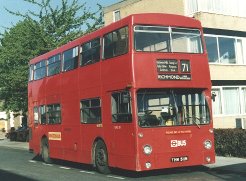 Nine were ready by the start date, 27th June 1987,
and the rest were gradually eased in as they became ready.
The DMSs joined in on routes 71, 85 and 213.
The unit was heralded as a success,
and in 1988 was further distinguished with its own fleetname:
a large yellow rectangle with Kingstonbus witten on it.
But by January 1990 Norbiton's services needed a transfusion.
Two-thirds of the DMSs went (four to Suttonbus!), replaced by Metrobuses.
Nine were ready by the start date, 27th June 1987,
and the rest were gradually eased in as they became ready.
The DMSs joined in on routes 71, 85 and 213.
The unit was heralded as a success,
and in 1988 was further distinguished with its own fleetname:
a large yellow rectangle with Kingstonbus witten on it.
But by January 1990 Norbiton's services needed a transfusion.
Two-thirds of the DMSs went (four to Suttonbus!), replaced by Metrobuses.
July 1990's tender changes saw the Norbiton DMS fleet reduced to two, which went in August.
The standard DMS had done its bit towards London Buses' continued operation in the Kingston area.
Kingstonbus DMS1511, on route 71 in unispired plain red.
Photo, used with permission, by Paul Watson
Bexleybus
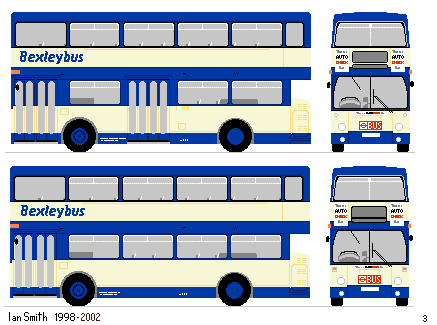 Bexleybus was the next low-cost unit, for a start in January 1988.
But where were the cheap buses to come from? Ah!
Lots of DMSs had been sitting idle in the open at AEC Southall since their withdrawal,
some for as long as five years. No write-down costs on these!
Seventeen were selected, had the grass scraped off, and were towed to Ensign for refurbishment.
Some needed remedial work before the trip.
Ensign overhauled them, fitted Autocheck equipment for dealing with prepaid tickets,
and gave them two-piece front indicator boxes. Livery was Eastbourne Buses' blue and cream.
(Eastbourne had painted some vehicles for trial purposes). They became Bexleybus 91-107.
Bexleybus was the next low-cost unit, for a start in January 1988.
But where were the cheap buses to come from? Ah!
Lots of DMSs had been sitting idle in the open at AEC Southall since their withdrawal,
some for as long as five years. No write-down costs on these!
Seventeen were selected, had the grass scraped off, and were towed to Ensign for refurbishment.
Some needed remedial work before the trip.
Ensign overhauled them, fitted Autocheck equipment for dealing with prepaid tickets,
and gave them two-piece front indicator boxes. Livery was Eastbourne Buses' blue and cream.
(Eastbourne had painted some vehicles for trial purposes). They became Bexleybus 91-107.
Another fourteen were bought back from Clydeside Scottish.
These had all been converted to single doorway.
Ensign overhauled these too (they did not need as much attention),
and fitted them with Autocheck gear. They had one-piece front blind boxes.
With the same blue and cream livery, they became Bexleybus 77-90.
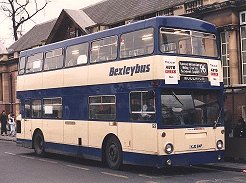 But Bexleybus was not going to be easy.
Bexleyheath garage staff accommodation and canteen were uninhabitable,
and Sidcup garage was going to close when Bexleyheath re-opened.
It was hoped that enough staff would transfer to the new conditions and wages,
but too few did. And despite the leavening of new leased Olympians, Metroriders and StarRiders
in the fleet, the elderly Nationals and Fleetlines had their problems.
The management had boasted that they could run Fleetlines as reliably as RTs. Well, they couldn't.
There were a number of embarrassing public failures,
and with the staff shortfall the unit rapidly earned a reputation for unreliability.
Titans began to replace the DMSs, at first in Bexleybus livery,
then in London red, from August 1989. All the DMSs had gone by March 1990,
but the damage was done: at tendering time Bexleybus was slaughtered,
and the services and garage, and the staff that wanted to, transferred to London Central.
But Bexleybus was not going to be easy.
Bexleyheath garage staff accommodation and canteen were uninhabitable,
and Sidcup garage was going to close when Bexleyheath re-opened.
It was hoped that enough staff would transfer to the new conditions and wages,
but too few did. And despite the leavening of new leased Olympians, Metroriders and StarRiders
in the fleet, the elderly Nationals and Fleetlines had their problems.
The management had boasted that they could run Fleetlines as reliably as RTs. Well, they couldn't.
There were a number of embarrassing public failures,
and with the staff shortfall the unit rapidly earned a reputation for unreliability.
Titans began to replace the DMSs, at first in Bexleybus livery,
then in London red, from August 1989. All the DMSs had gone by March 1990,
but the damage was done: at tendering time Bexleybus was slaughtered,
and the services and garage, and the staff that wanted to, transferred to London Central.
Bexleybus 92, alias DMS2064, on route 96.
Photo, used with permission, by Paul Watson
SuttonBus
Suttonbus was a bit different. The Fleetlines were all B20s,
and the reliability of that fleet was being transformed by the fitting of Iveco engines.
The main London Buses fleet was being reliveried too,
as management at last began to realise that people
are more likely to consider travelling by bus if the buses are smart.
Packaging matters. So livery trials were carried out before Suttonbus,
with white bands, yellow bands and a variety of skirt colours: grey, black, maroon and mushroom.
The livery chosen was red, with mushroom skirt, 2" yellow band and yellow Suttonbus lettering
and phone number.
Sutton was familiar with Fleetlines too, and knew what could be done with them.
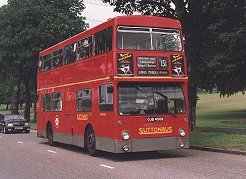
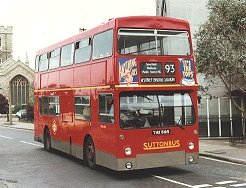 Suttonbus began as a separate cost-unit from 26th November 1988.
One of their tasks was to continue operations on Surrey contracts,
including DMS service 522 out as far as Gatwick Airport!
Suttonbus began as a separate cost-unit from 26th November 1988.
One of their tasks was to continue operations on Surrey contracts,
including DMS service 522 out as far as Gatwick Airport!
DMS2450 displays Suttonbus livery on route 151, June 1991,
as does DMS2519 on the 93.
Photos, used with permission, by Paul Watson
Enthusiasm for separate units waned as privatisation loomed,
and Suttonbus was quietly absorbed back into London General.
January 1991 saw Metrobuses start to arrive at Sutton,
and by April 1992 the last Fleetline had gone from there.
Two galleries of captioned photos of Sutton Fleetlines
and Suttonbus are provided by Paul Watson.
Appendix: Unit fleet lists:
Kingstonbus
prepared by Kent Engineering (Canterbury):
DMS 678, 711, 719, 1426, 1477, 1488, 1500, 1511, 1537, 1626, 1867, 1900;
prepared by British Leyland (Nottingham):
DM1804, DMS 714, 819, 1852, 1862, 1884, 1890, 1893, 2006, 2008;
prepared by LRT Bus Engineering (Chiswick):
DMS 717, 1447, 1473, 1837, 1859, 1873, 1889, 1901, 1904, 1950, 2103
provided as spare parts Christmas trees:
DMS 1499, 1450, 1985, 1996. 1985 was rebuilt using parts from the others, and re-entered service.
Bexleybus
from Clydeside (H44/31F), #77-90:
DMS 1492, 1580, 1610, 1649, 1656, 1657, 1669, 1670, 1671, 1679, 1683, 1686, 1687, 2021
from store at AEC (H45/27D): #91-107
DMS 2063, 2064, 2068, 2074, 2108, 2109, 2110, 2112, 2118, 2121, D1146, 1160, 1195, DMS 2125, 2143, 2156, 2166.
provided as spare parts Christmas trees:
DMS 2100, 2158

 Bus Stop Bus Stop
 Part 1. Part 1.
 Part 4. Part 4.
 Part 5. Part 5.
 Part 6. Part 6.
 bus histories. bus histories.
 photos. photos.
|

